‘This machine, a so-called MBE, makes our experimental computer chips using new materials’, Brinkman says. The complicated looking, stainless-steel instrument indeed is beauty and according to Brinkman, its achievements are impressive. Jokingly: ‘I almost feel like a proud father.’ About six steel cylinders point down from the main body of the instrument. Brinkman: ‘In these cylinders we place new materials we like to investigate, for example, metals like bismuth, tellurium or antimony. These are consequently evaporated and condensate on a silicon chip in the upper part of the machine. So, we can build up a very thin layer of such a metal on a chip.’ In the next step, the scientists use nano techniques to edge very tiny channels into this layer to form the electronic circuit. Now the chip, based on new material, is ready for testing.
Complicated circuit
Modern computer chips have revolutionized our society, resulting in the digital age, where smart phones, computers and internet are indispensable parts of our daily lives. Computer chips are made from silicon-based transistors that act as electronic switches that either block or pass an electrical current. This translates in the well-known 0’s and 1’s, the basis for all digital calculations. A single silicon computer chip may house millions, or even billions, of transistors that control electrical currents through tiny channels inside the silicon surface of the chip. Together with other electronic components, like resistors and capacitors, they make up a complicated electronic circuit, a network that is the basis of the digital highways that allow internet to function and computers and other electronics to perform their tasks.

Inefficient transistors
The digital highways, including data centers, use huge amount of energy. According to KTH Royal Institute of Technology in Sweden, in 2021 internet consumed more than ten percent of the world’s total electricity need. In data centers, more than 80 percent of this energy is used to run the servers and cool the equipment. When you realize that a single data center needs a complete wind park to receive sufficient energy, the need for less energy consumption is quite urgent. ‘Roughly about half of all this energy is lost due to inefficient communication between transistors, the fundament of modern electronics, including computers’, Brinkman says. ‘This lost energy transpires as heat.’ The reason for this energy loss lies in the chip material, silicon. When the electrons, forming an electrical current, are passing through a silicon channel, they collide with tiny impurities inside the silicon. As a result, they don’t follow their straight path, but are scattered in different directions. This results in heat production, and consequent loss of energy.
New materials
But science may have an answer that could solve these energy losses. ‘There are the so-called topological materials, for example Bismuth-telluride, that have very special properties for the conductance of electricity’, Brinkman explains. ‘Instead of being scattered when colliding with the unavoidable impurities, in these materials, the electrons are forced to continue their straight path through the channel. As a result, there is no heat production and no loss of energy.’ Brinkman and his team want to investigate these new materials for possible application in a new, energy-efficient computer chip. Besides testing the electrical conductivity and possible energy losses in known topological materials, like Bismuth telluride, they will also design suitable new materials.
More robust quantum computer
When successful, Brinkman’s research not only will make computer chips more energy-efficient, it may also have important applications for quantum computers. The building blocks of a quantum computer are quantum bits, or qubits, for example electrons. These electrons are not static particles, but spin around their axis in two possible directions. These different spin directions correspond with the ‘0’s’ and ‘1’s’ in a data bit of a conventional computer and are the basis of quantum calculations. However, these spins are very sensitive to disturbance due to magnetic fields that are all around us. By using a completely different approach for a qubit design, Brinkman hopes to set a step towards more robust quantum computers. ‘For this new qubit, we don’t make calculations based on the spin direction of the electron anymore, but we use the order of a row of different qubits on a chip as ‘0’s’ and ‘1’s’ and perform quantum calculations’, Brinkman explains. ‘When a qubit swaps place with another qubit, that is a different configuration, similar to a ‘0’ or a ‘1’. This qubit order is much less sensitive for disturbances.’ However, scientists need topological materials that are also superconducting for these new qubits. Brinkman: ‘So, topological materials have properties that can be used to make energy-efficient chips, but at the same time these properties also allow to build a more robust quantum computer!’
Major challenge
Despite the great potential of the project, Brinkman sees some challenges the team needs to overcome. ‘We will use nanotechnology inside a protective environment to build our new materials, and this sometimes requires that a single atom layer is applied on top of a ground material’, he explains. ‘That means we have to construct that layer one atom at a time, but our new MBE machine is well suited to the task.’ But such a single-atom layer is vulnerable: in the outside world it might be damaged by, for example, oxidation. Therefore, scientists have to find a way to protect their newly built materials. Finally, a major challenge is to measure the electric conductive properties and possible energy loss extremely accurately. To achieve this, the measurements are taking place close to absolute zero temperatures, i.e. -273 Celsius. But despite these potential difficulties, Brinkman is confident the project will be successful: ‘We have ten years to run this project. It will not only give us time to develop and apply these new materials, we may even have the possibilities to take little side paths and investigate unexpected applications.’









